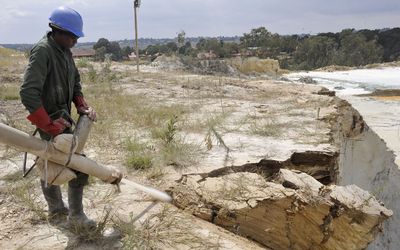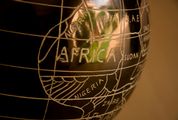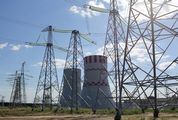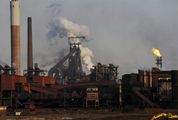WHO tests for uranium poisoning near Johannesburg
by Agency Staff,
2016-03-15 18:46:55.0
The World Health Organisation (WHO) is collecting samples west of Johannesburg to see if residents near SA’s biggest city are suffering from excessive uranium pollution due to ore dumps from 130 years of gold mining.
The Geneva-based United Nations unit will analyse hair samples from about 1,600 people living in neighbourhoods near mine dumps, mainly west of Johannesburg, it said. Uranium, which can cause cancer, can be ingested through drinking contaminated water or inhaling dust.
"The objective is to study the environmental exposure to uranium and its decay products of the population living in close proximity to gold mine tailing dumps in and around Johannesburg," the WHO said. "These residue areas are often densely populated and create the potential for substantial levels of exposure to uranium."
Johannesburg was spawned by a gold rush when the metal was discovered in the 1880s with the Witwatersrand, the world’s biggest gold field, arcing around the south and west of the city. While the country dominated global gold production for most of the past century, production is now a fifth of what it was at its peak in about 1970. Production peaked at 7,295 tonnes in 1980, falling to 639 tonnes by 2006, according to the Chamber of Mines.
Radioactive dumps
Residents of Johannesburg and surrounding communities live among an estimated 600,000 metric tonnes of uranium buried in huge mounds of waste material hauled up in the mining process, according to Dr Frank Winde, an academic at North West University, who is working with the WHO on the study.
The radioactive metal can work its way into rivers when it dissolves in rain and runs off the mounds, or when abandoned mines are flooded, according to Dr Winde, a German-born scientist who has studied the effect of uranium on SA’s environment for 30 years. On windy days, areas near the dumps may be coated in toxic dust.
The Federation for a Sustainable Environment, a nongovernmental organisation led by environmental campaigner Mariette Liefferink, is helping the WHO collect hair samples from eight locations near Johannesburg as well as control sites.
Limited research
"To date, there has been little epidemiologic research on the exposure of these populations and their risk of cancer and other adverse health outcomes," the WHO said. "This pilot should be critical in opening the door to further research in order to assist governmental authorities with putting in place the best possible strategies to prevent uranium contamination in the affected areas."
South African gold companies have also been targeted by former employees for causing silicosis, a respiratory disease resulting from dust exposure.
Gold production was dominated in the 20th century by Anglo American, Gencor and Gold Fields. The biggest miners are now AngloGold Ashanti, Sibanye Gold and Harmony Gold Mining.
Bloomberg

A Mintails employee uses a high-pressure hose to send chunks of a mine dump tumbling into a channel on its way to the gold plant. Picture: FREDDY MAVUNDA
The World Health Organisation (WHO) is collecting samples west of Johannesburg to see if residents near SA’s biggest city are suffering from excessive uranium pollution due to ore dumps from 130 years of gold mining.
The Geneva-based United Nations unit will analyse hair samples from about 1,600 people living in neighbourhoods near mine dumps, mainly west of Johannesburg, it said. Uranium, which can cause cancer, can be ingested through drinking contaminated water or inhaling dust.
"The objective is to study the environmental exposure to uranium and its decay products of the population living in close proximity to gold mine tailing dumps in and around Johannesburg," the WHO said. "These residue areas are often densely populated and create the potential for substantial levels of exposure to uranium."
Johannesburg was spawned by a gold rush when the metal was discovered in the 1880s with the Witwatersrand, the world’s biggest gold field, arcing around the south and west of the city. While the country dominated global gold production for most of the past century, production is now a fifth of what it was at its peak in about 1970. Production peaked at 7,295 tonnes in 1980, falling to 639 tonnes by 2006, according to the Chamber of Mines.
Radioactive dumps
Residents of Johannesburg and surrounding communities live among an estimated 600,000 metric tonnes of uranium buried in huge mounds of waste material hauled up in the mining process, according to Dr Frank Winde, an academic at North West University, who is working with the WHO on the study.
The radioactive metal can work its way into rivers when it dissolves in rain and runs off the mounds, or when abandoned mines are flooded, according to Dr Winde, a German-born scientist who has studied the effect of uranium on SA’s environment for 30 years. On windy days, areas near the dumps may be coated in toxic dust.
The Federation for a Sustainable Environment, a nongovernmental organisation led by environmental campaigner Mariette Liefferink, is helping the WHO collect hair samples from eight locations near Johannesburg as well as control sites.
Limited research
"To date, there has been little epidemiologic research on the exposure of these populations and their risk of cancer and other adverse health outcomes," the WHO said. "This pilot should be critical in opening the door to further research in order to assist governmental authorities with putting in place the best possible strategies to prevent uranium contamination in the affected areas."
South African gold companies have also been targeted by former employees for causing silicosis, a respiratory disease resulting from dust exposure.
Gold production was dominated in the 20th century by Anglo American, Gencor and Gold Fields. The biggest miners are now AngloGold Ashanti, Sibanye Gold and Harmony Gold Mining.
Bloomberg


























Change: 0.73%
Change: 0.83%
Change: 0.72%
Change: 0.75%
Change: 1.51%
Data supplied by Profile Data
Change: 0.58%
Change: 0.00%
Change: 0.73%
Change: 0.00%
Change: 0.01%
Data supplied by Profile Data
Change: 1.47%
Change: 0.99%
Change: 1.16%
Change: 1.00%
Change: 1.08%
Data supplied by Profile Data
Change: -0.05%
Change: 0.52%
Change: 0.13%
Change: 0.88%
Change: 2.05%
Data supplied by Profile Data